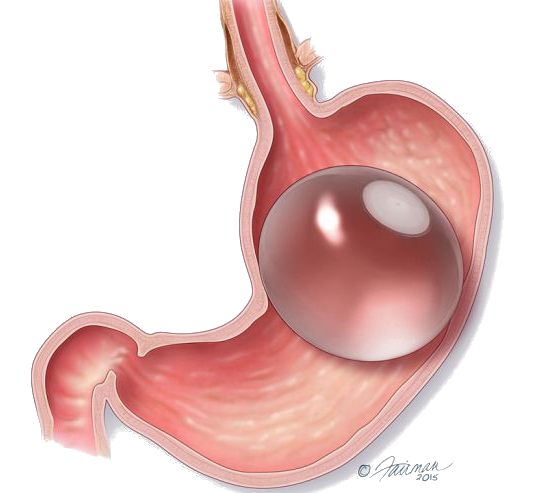Gastric Balloon
What is intragastric balloon?
Intragastric ballon is a ball-shaped substance made of different materials which we place into the stomach. The intragastric balloon application is a process that reduces the food intake of obese patients.
Who Is Suitable for Gastric Balloon?
We usually recommend the gastric balloon in individuals who have not passed the surgery limit. This means; If the BMI of the patients is low, a gastric balloon is suitable. Sometimes it is used before the operation to provide fast weight loss in super obese patients.

How is intragastric balloon application done?
Intragastric balloons are placed under endoscopic vision. Patients are taken to the endoscopy room after necessary preparations. A form of anesthesia called sedation is applied. In this type of anesthesia, patients do not remember the procedure and the procedure is performed comfortably.
First, the esophagus, stomach and duodenum are controlled with an endoscope. After it is determined that there is no obstacle, the balloon is sent into the stomach in a deflated form. After this, endoscope is inserted into the stomach in order to observe the filling stage. At this stage, a tube connected to the balloon comes out of the patient’s mouth. With the help of this tube, the balloon is filled to the desired amount. Then, the tube is separated from the balloon and the balloon remains in the stomach.
After the last control, the endoscope is taken out and the procedure is terminated. Then the patient is taken to the recovery room and after about half an hour of rest, he can return to his normal daily life. After the procedure, we do not recommend patients to drive because they may have difficulty doing fine work for a few hours.
How is gastric balloon method performed without endoscopy?
More recently, an intragastric balloon type that does not require endoscopy has been used. In this balloon application, the patient swallows the deflated balloon with the help of a glass of water. The balloon lands on the stomach. After making sure of its location, the desired amount of medicated liquid is given from the tube. The balloon is fiiled and checked under X-rays. After reaching sufficient filling, the tube is pulled and the gastric balloon remains in the stomach. Since the material of this type of balloon is absorbable, at the end of 4 months it is removed from the body. Therefore, it is not necessary to perform endoscopy to remove the intragastric balloon.
Frequently asked questions
There are many types of intragastric balloons that have been released on the market. The most commonly used types are the types that are used for 6 months, filled with liquid or air. In addition, it is frequently used in 1-year balloons whose volume can be changed. In addition, an intragastric balloon that remains in the stomach for 4 months and can dissolve is applied. Which balloon type will be used is decided as a result of the extensive evaluation made by the doctor and the patient
Although it varies between patients, patients may feel uncomfortable sensations such as nausea, vomiting, abdominal pain and indigestion until their bodies get used to the balloon. These feelings can last up to 3 days. These feelings are usually at a level that can be overcome with medication. Unfortunately, one or two out of 10 patients with intragastric balloon may have to remove the balloon early as a result of excess nausea and vomiting.
No, all gastric balloons should be removed from the stomach. The main reason for this is that the gastric balloon, which is a foreign body, damages the stomach wall due to the pressure it applies. Balloons made of non-absorbable material need to be removed by applying endoscopy. Endoscopy is not necessary to remove the balloons made of absorbable material, they are automatically removed from the body.
Since gastric balloons are not inflated with excessive pressure, they deflate rather than burst. Intragastric balloons are presented to patients after very comprehensive tests. Therefore, the possibility of loss of function is very low.
After the intragastric balloon is removed, the condition of the patients becomes same with the preprocedure. In order for patients not to regain their weight, lifestyle and nutritional changes should be implemented in their lives. Contrary to popular belief, quite easy and small changes makes significant differences. For this reason, we have doubled our focus on our PPS program.



